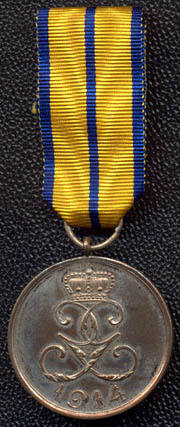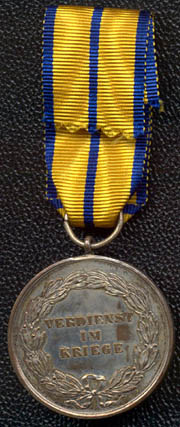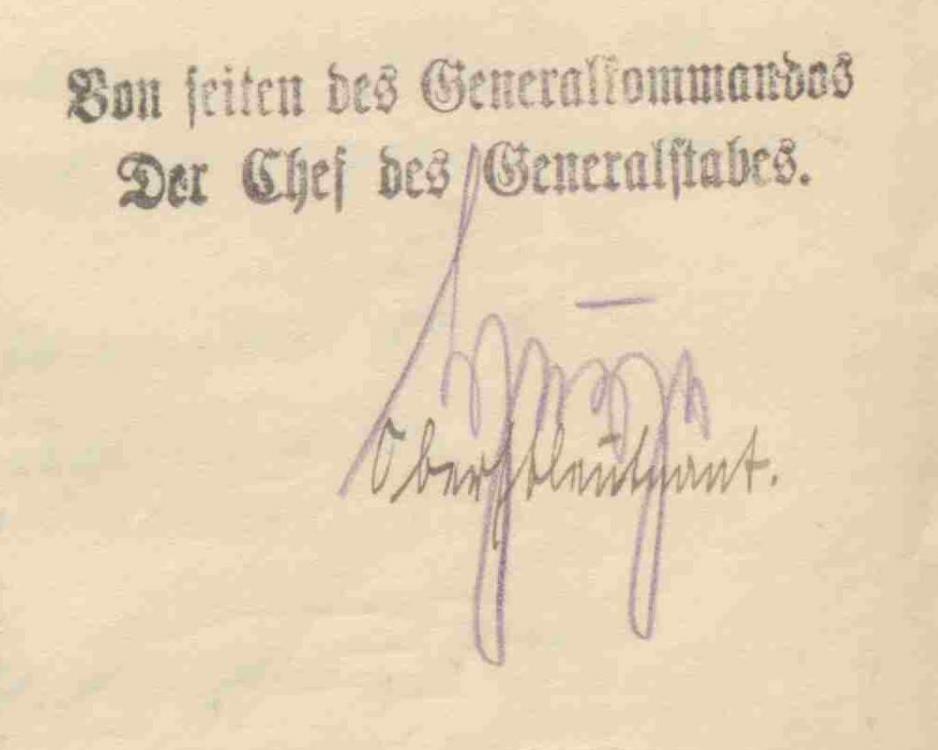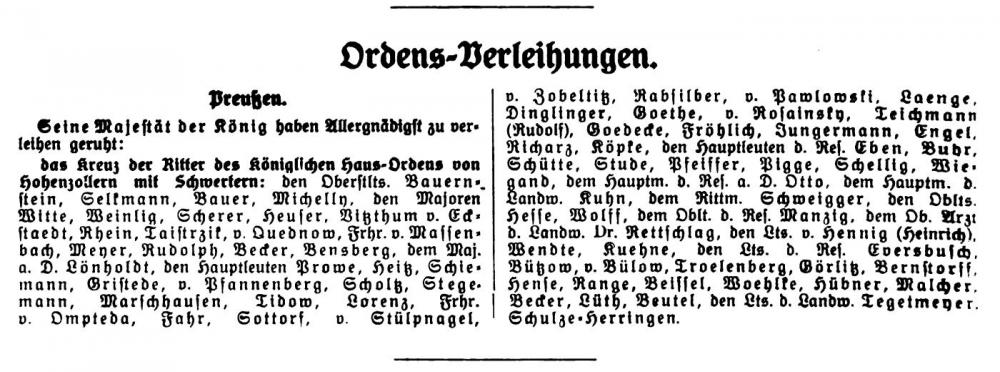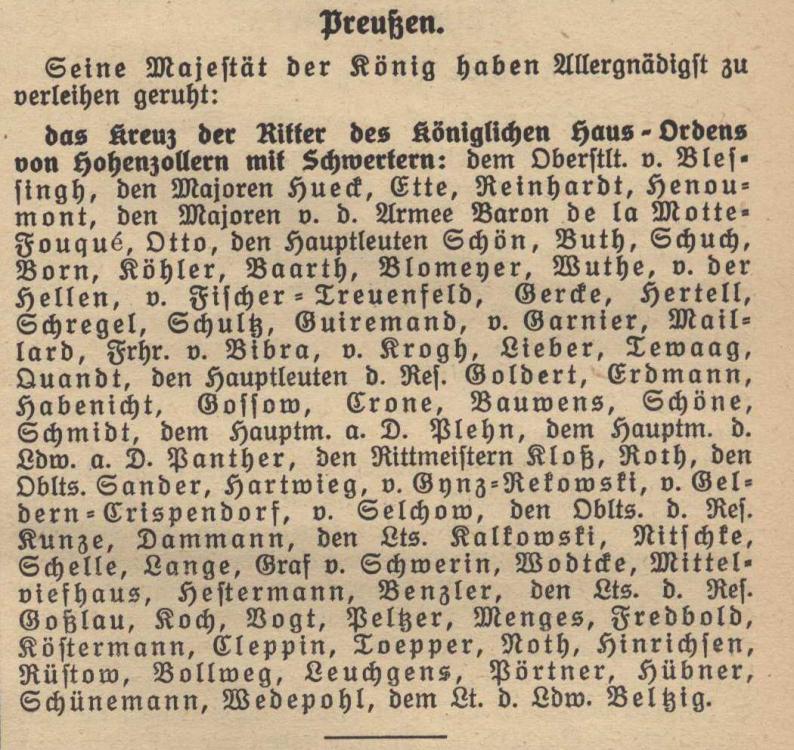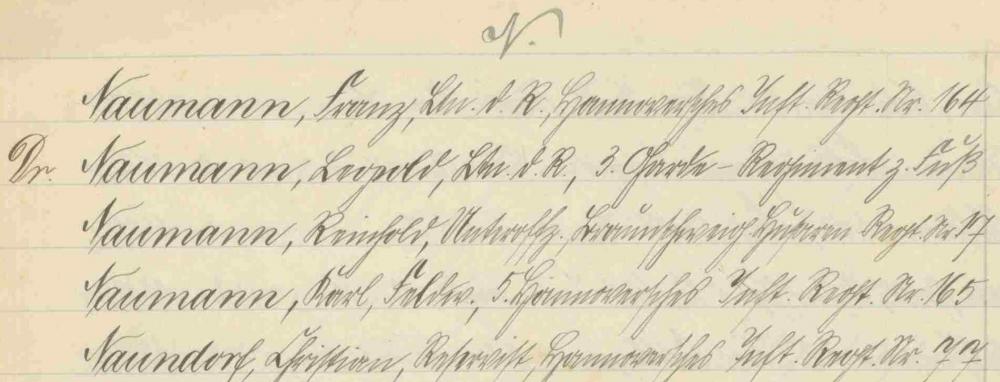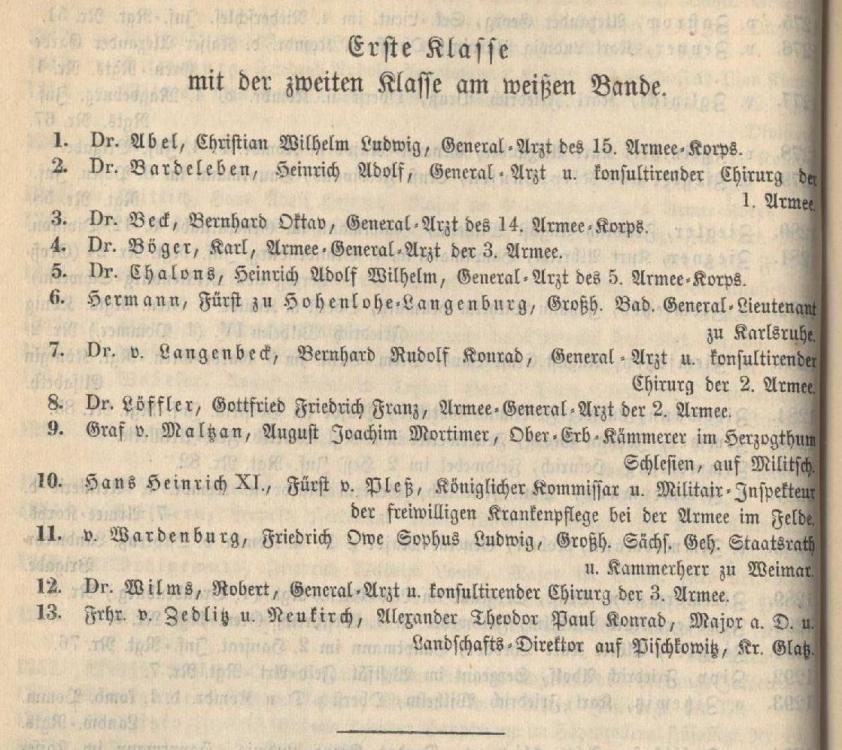-
Posts
4,908 -
Joined
-
Last visited
-
Days Won
97
Content Type
Profiles
Forums
Blogs
Gallery
Events
Store
Everything posted by Dave Danner
-
There is also the Fliegererinnerungsabzeichen, another badge between a qualification and a commemorative. I think as originally intended, you got it if you were no longer on flying status, so you could not wear your Flugzeugführerabzeichen or Beobachterabzeichen, but you had to have been a qualified pilot/observer for some period to qualify. Also, regarding Wehrmacht assault/battle badges, don't forget that originally only Panzer and infantry troops had their own badge. The Panzer Battle Badge, as well as the earler Condor Legion version, probably were a result of the WW1 badge, while the infantry also succeeded in getting their own version. The General Assault Badge was created 6 months later, as was the bronze version of the Panzer Battle Badge, and the Flak badge came over a year later. From the US perspective, as I understand it, the CIB was created in WW2 specifically because of the higher casualty rates among the infantry, with the Combat Medic's Badge added because of the similarly high casualty rate among medics. The other branches failed to get their own badges until the 2000s, when the more generic Combat Action Badge was created.
-
I vaguely recall seeing a reference to that somewhere, but I can't remember where. Something along the lines of "Nachrichten-Offizier der OHL beim AOK #". Was it discussed in Cron? Maybe I saw it in another Kriegsrangliste-Auszug. BTW, Nachrichten is probably among the most commonly mistranslated German military terms in English. As I recall, there was a book about WW2 German infantry that always translated it as "intelligence", so apparently infantry battalions had intelligence platoons. The same book also always translated Granatwerfer as "grenade-launcher", even when it was clear that the subject matter was mortars. I often cannot tell when Unteroffizier is supposed to be the specific rank or NCO in general.
-
Char. Oberstleutnant z.D. Karl Friedrich Weller, *19.5.1858 in Linz, Rheinprovinz, †xx.2.1927 in Braunfels. He was the Vorstand of the Artillerie-Depot in Karlsruhe before the war (22.3.12 Vorstand, 18.4.13 Charakter als OTLzD). According to the Stammliste of IR 93 (in which he served from 1895-99), he was from 29.9.14 Kdr. Ldst.-Inf.-Btl. Donaueschingen, from 12.3.15 Kdr. Ldst.-Inf.-Ers.-Btl. Rastatt, and from 26.10.15 a Btls.-Kdr. in LIR 40. Then, from 18.3.16 he was 2. Stabsoffizier of the Russenlager in Rastatt, and from 1.8.16 Kdt. Kriegsgefangenlager Wetzlar. On 13.9.16 he received a Patent as an OTLzD and on 13.5.19 he wa retired with the Charakter as Oberst a.D. His prewar service was in Jäger-Bataillon Nr. 11 (where he was an Einjähriger-Freiwilliger in 1879-80), IR 57 (which he entered as an active officer aspirant on 1.2.1881), IR 93, IR 180 and IR 132. When he was placed z.D. on 17.1.12, it was with the uniform of IR 132. Known decorations are the Roter-Adlerorden 4.Klasse, Eisernes Kreuz 2.Klasse, Dienstauszeichnungskreuz, Centenarmedaille, Ritterkreuz 1.Klasse des Hzgl. Anhaltischen Hausordens Albrecht des Bären, Hzgl. Anhaltische Regierungs-Jubiläumsmedaille, and Ritterkreuz 1.Klasse des Kgl. Württembergischen Friedrichs-Orden. I would guess that he also received the Baden Kriegsverdienstkreuz, since he likely got a Baden decoration but is not in the Zähringer Löwe rolls.
-
Christophe, I have 9 of them: 7.6.15 Facius, Karl, Hptm., IR 104 11.6.15 Eulitz, Fritz, Hptm., IR 104 11.6.15 Naumann, Walther, OLt.d.R., IR 104 11.6.15 Berger, Max, OLt.d.R., IR 104 11.6.15 Schuricht, Rudolf, Lt.d.R., IR 104 11.6.15 Heidemann, Erwin, Lt., IR 104 11.6.15 Hammer, Hans, Lt., IR 104 11.6.15 Kühn, Walter, Vfw.d.R., IR 104 11.6.15 Fritzsch, Otto, Vfw., IR 104 I don't have a complete list. In the limited time I was in Detmold, I only wrote down LK-recipients with other decorations, so I might have skipped a few junior soldiers who only had an EK2 or no other awards listed. All of these except Naumann, Schuricht and Hammer can be ruled out for the ribbon bar because of other awards. Facius had the Prussian KO4, for example, and Eulitz the HOH3X. Berger had the SLD2 and Heidemann had the SV3bX. Kühn, Lt.d.R. on 15.7.16, had both the silver and gold St. Heinrich-Medaillen and the Ritterkreuz of the Order, so three St. Henry ribbons. Fritzsch had the silver St. Heinrich-Medaille, but nothing on the Albrechts-Orden ribbon. I've only seen a fraction of the LK receipts, though. There are probably a number of other Saxons out there.
-

Accuracy in Movies - Does it Matter?
Dave Danner commented on Brian Wolfe's blog entry in News From the Home Office.
For any film, not just war movies, but especially in war films and in fantasy and science fiction films where the setting is important, some amount of accuracy or at least verisimilitude (wow! that's hard to spell) is necessary. This is necessary for the so-called "willing suspension of disbelief" - you know you are watching something that is not real so you need a certain attention to detail to accept this fictional world. For a war movie, especially one based on actual events such as "Dieppe" and not just a fictional story like "Kelly's Heroes" or "M*A*S*H", I would think a higher level of attention to detail would be necessary. Depending on the conflict, you might have viewers who actually experienced the events in question or a large amount of actual documentation of the events. As Brian noted, "Saving Private Ryan" received a lot of praise from D-Day veterans for its portrayal of the landings, but I can't remember how many posts I read criticizing other aspects of the film on military history and military collector forums. As I recall, many WAF posters were especially critical of the movie using SS soldiers at a time when Waffen SS units had yet to arrive in Normandy. Even a relatively minor detail such as the haircuts was criticized - Spielberg's Germans had buzz-cuts more like modern neo-Nazis rather than the longer hair far more common among 1940s German young men. Compare the 1993 German film "Stalingrad" which got that detail, as well as many others, correct. Many people simply have a higher or different threshold for the "willing suspension of disbelief", so their expectations might probably never be satisfied, even in a documentary (and plenty of documentaries are quite bad themselves in their attention to detail, and often worse, since they do not have the budget of a major film). One man's "howling error" might be another's "eh, who cares". For example, just noting what I mentioned above, I was not bothered by the use of the Waffen-SS in SPR, because I've become used to Hollywood's portrayals of German soldiers. But the haircut thing bothered me, because it took me out of the film and made me think of the many caricatures of Germans in Spielberg films. For that matter, many the Americans in SPR were typical war-movie caricatures (e.g., tough-talking Brooklynite, quiet crack-shot farmboy). "Band of Brothers" had some problems, but it was definitely a huge improvement and the benchmark against which many war movies are now measured. The thresholds in many cases are simply different, not "higher" or "lower". As Chris notes, one person might note uniform details that would mean nothing to me, much less to the average viewer. Others might note equipment details and be indifferent to uniforms, because weapons or gear is their thing. There was a TV-movie about the WW1 Lost Battalion that as I recall received praise for the accuracy of the weapons for the unit and time period, showing the US soldiers with Enfields, Chauchats and M1911s (rather than M1911A1s). I couldn't tell you the difference between an M1911 and an M1911A1, but I did notice that a German officer was wearing his EK1 closer to man-boob level rather than on the lower chest. With regard to another movie Brian mentions, "55 Days at Peking", it was at the time rather notorious for its budget, which went overboard in recreating downtown Peking in giant sets which still exist as a housing development near Madrid. Bad acting notwithstanding (and I think Ava Gardner was much worse than Heston), it still gets some credit from me for being pretty much the only Western movie ever made about the Boxer Rebellion and the Western response. Today, the movie is probably more notorious for its stereotypical Chinese characters (especially the British actors playing Chinese characters). I will conclude with a shout-out to "Kelly's Heroes". Here was a 1970 anti-war comedy, yet in many areas the attention to detail was far ahead of even serious films of the period such as 1970's "Patton". The Tiger tanks were visually modified Yugoslav T-34/85s, so the dimensions were off, but there was not a lot more you could have done there with the budgets of the time. But the detail that always sticks in my head was a comment by the hippy tank commander played by Donald Sutherland, noting that his men had placed pipes over the barrels of their Sherman tanks so the Germans would think they had a larger gun than the normal Sherman. This line of dialog had no relevance to the plot of the movie. It was apparently only included to appease nit-pickers, since the Shermans in the movie were actually M36 tank destroyers, Shermans upgraded with 90mm guns, provided by the US to Yugoslavia in the late-1940s. For its battle scenes, the big-budget "Patton" did little more than slap a black cross on Spanish Army M-47s, which seems pretty sad compared to the efforts made by the lower budget comedy. -
And now to revisit this topic again. Apparently, Roth's SA3aX list is in error. It would appear that Hptm.d.L.a.D. Georg Tasche was the Hptm. in Landwehr-Brigade-Ersatz-Bataillon who received the SA3aX, not Hptm.d.R. Albrecht. Georg was awarded the Lippe Kriegsverdienstkreuz on 23.7.1915 as Kgl. sächs. Hptm.d.L.a.D., Kp.Fhr. LdwBrigEB 47, LEIR 5, Div. v. Menges. His other listed awards at that time were the EK2, SA3a, SLD2 and the 1905 Thronanspruchsmedaille. I cannot find the Tasche award in the 1916 Saxon Militär-Verordnungsblatt. I assume Roth found it in the Ordenskanzlei Akten, but maybe it was mis-listed there. Although neither Tasche is a match, there are several possibilities for Christophe's ribbon bar shown above. Among these are OLt.d.R. Walther Naumann, Lt.d.R. Rudolf Schuricht, and Lt. Hans Hammer (later Generalmajor), all awarded the LK on 11.6.1915 while serving with IR 104. I'm sure there are others.
-
The Wehrmacht did not double-count war years. Police time counts, so as Capell entered service in 1912, if there was no break in service when he transitioned from the Prussian army to the police, he would have been eligible for the WHDA1 in 1937. Eugen Richter had the Schlesischer Adler 2.Klasse, which would have been permitted to be worn in the Wehrmacht. There may be other possibilities out there. We do not know how many Imperial officers went to the police or were civilian employees of the Reichswehr (Angestellter im Reichsdienst gem. § 56 W.V.G.) whose service time counted toward the Wehrmacht DA. Also, we do not know for certain how many people received both the LüH and the MMV2.
-
Hi, Revisiting an old topic to correct/supplement what I wrote above. Having compiled the entire Anhalt rolls, I would say that the combination with Anhalt, Braunschweig and a Saxon Duchy most likely points to a staff officer with the Magdeburg-based IV.Armeekorps. All of Anhalt belonged with the IV.AK area, as did most of Sachsen-Altenburg, and IR 93 and IR 153 belonged to the same division. The Duchy of Braunschweig had several exclaves in the IV.AK area, most notably Blankenburg am Harz, where II./IR 165 was garrisoned.
-
The cut-off date for editing the DOA (Redaktionsschluß) was 27.01.1908, so they should have gotten it right. As bad as editing has gotten in the modern digital era, where we just hit "reply" rather than going through layers of fact-checkers and editors, one would have hoped that they were better back then, but mistakes happen.
-
There is no single roll for the Medal for Merit in War. They are included in a master roll of all Schwarzburg awards from the early 1800s on. This "roll" is a book which is about two feet in height and which I could not even open without propping up a stack of other books next to it. I have compiled the rolls for the Ehrenkreuz from 1909 (when Fürst Günther Victor became ruler of both principalities) to 1918, including awards with swords and with the Eichenbruch. For these, there were separate rolls. I also compiled a partial list of the Ehrenmedaille with Eichenbruch, but there was only a roll for one of the principalities. Also, some ephemera like the Sondershausen Rettungsmedaille, one of the rarest German awards (19 awards between 1868 and 1918). These are in the process of being published.
-
Given the regiment, it seems like it should be another Sachsen-Meiningen award. Swords to the prewar silver medal of the Ernestine Hausorden might make sense, although at least 175 enlisted men in LGR 100 received the Ehrenmedaille für Verdienst im Kriege. I have no idea how Saxony chose to abbreviate this award.
-
Actually, of all the numbering choices, the "200-series" makes the most sense. At the time, regular regiments only went up to Nr. 182, and there weren't corresponding RIRs or LIRs for many of these. The 200-series RIRs were probably not expected to be more than a wartime expedient, and starting at Nr. 201 meant they would not overlap with existing regimental numbers. What perplexes me is when they assigned lower RIR/LIR Nrs. to wartime regiments with no connection to the similarly numbered regular regiments. For example, RIR 64 and RIR 93 were raised on mobilization by the Gardekorps. RIR 64 had no connection to IR 64, a Brandenburg regiment who formed its reserve formation, RIR 24, with IR 24, its mate in the 12. Infanterie-Brigade. Similarly, RIR 93 had no connection to IR 93, which formed its reserve formation, RIR 36, with FR 36, its mate in the 15. Infanterie-Brigade. When LIR 93 was formed in 1915, one of its battalions came from Anhalt, so the numbering might make sense, but the other two battalions were from Sachsen-Altenburg and Hannover. And LIR 94, unlike RIR 94, had no connection to IR 94 or Sachsen-Weimar-Eisenach.
-
Probably not JB 14. Maj. Hans Frhr. Schenck zu Schweinsberg had the HOH3X and a number of other awards, and the rest of the active JB 14 officers in Finland were lieutenants. I can't be certain, but with the RAO4 and KO4, as well as the Mecklenburg and Finnish decorations, I would say perhaps a navy officer or naval engineer.
-
Dauter is probably the Lt.d.R. Dauter from the reserve of IR 14, who was promoted to OLt.d.R. on 14 October 1915 while serving in IR 357. IR 375 was not at Verdun; it was on the Eastern Front in 1916. Also, IR 357 is connected to IR 399, as a bataillon from IR 357 was transferred to IR 399 when that regiment was formed in September 1916. According to the 1911 ranklist for reserve/Landwehr officers, Dauter was a Landwirt in Haseleu, Kreis Regenwalde. The 1914 Güter-Adreßbuch für die Provinz Pommern gives his first name as Johannes, and shows him as the administrator of Gut Haseleu on behalf of the Gutsbesitzer, Oberstlt.z.D. Wilhelm v. Alten. In the Prussian Verlustliste of 30 January 1915, we find a Lt.d.R. Hans Dauter, born in Münsterwalde, Marienwerder, lightly wounded with 4./Brig.Ers.Btl. 8. BrigEB 8 later became III./IR 357, so Johannes (Hans) Dauter seems to be your guy. Simon is too common a name. I can't connect any of the various Simons to IR 357 or IR 399 or the units which formed these regiments.
-
The order in the photo is indeed the HEK2b. I mis-wrote above that this was a neck order, but as you note, the HEK2a was a neck order. So the ribbon bar is not a match, unless he got an upgrade of his HEK2b to a 2a, removing it from the ribbon bar. I have no information one way or another, especially since that award continued (continues?) to be awarded after the war.
-
Heye, Wilhelm (1869-1947) Highest rank and position: Generaloberst, Chef der Heeresleitung German Wikipedia entry: https://de.wikipedia.org/wiki/Wilhelm_Heye English Wikipedia entry: https://en.wikipedia.org/wiki/Wilhelm_Heye Lexikon der Wehrmacht: http://www.lexikon-der-wehrmacht.de/Personenregister/H/HeyeWilhelm.htm Signature from December 1915, as Chief of the General Staff of the Landwehr-Korps:
-
If the Rufname of "Julius" is correct, then the first one should be: Winkelsesser, Julius Emil Theodor, *27.2.1880 in Detmold, Landrichter ebenda; Hptm.d.L. II, Regts.-Adj., LIR 15. He was awarded the Lippe-Detmold Kriegsehrenkreuz für heldenmütige Tat (LKEK) on 26.4.1917. He had earlier received the Lippe-Detmold Kriegsverdienstkreuz (LK) on 14.4.1915. He would later receive the Fürstlich Lippisches Hausorden des Ehrenkreuzes 4. Klasse, 1. Abteilung, mit Schwertern (LDH4aX) on 12.10.1918. He also received the Kreuz für treue Dienste (SLK) from Schaumburg-Lippe on 3.5.1916. The only other Julius to receive the LKEK before Winter 1917/18 was Julius Schönian, but he was an active Major. Regarding the number of awards, the numbering of the receipts for the LKEK runs to 740, but there were 2 repeated numbers, so there were 742 total award receipts.
-
Field Service Decoration (Felddienst-Auszeichnung). This was a general service or campaign medal, instituted in 1839 and awarded retroactively back to the Napoleonic Wars. Date bars could be worn on the ribbon to indicate campaign service. There were 18 bars: 1805 1806 1806-1807 1807 1808-1813 1809 1809-1810 1812 1813 1814 1814-1815 1815 1848 1849 1866 1870 1870-1871 1871
-
For the 1870 version, there were several EK1/EK2w combinations, but the 1870 EK2 was routinely awarded on the white-black ribbon to medical personnel, which was not the case with the 1914 version. I suppose there might be some older recalled doctors who had a 70EK2w and a 1914 EK1, as well. Maybe even a 70EK2w with a silver Spange and an EK1, although maybe award of the Spange would imply award of the black-white ribbon. The ribbon itself might show up for other awards. I know of at least 30 medical and intendant-types who had a Red Eagle or Crown Order with swords on the white-black ribbon from China or the colonies, and an EK1 in World War I. Adolf Köstlin, an Intendanturrat with the Gardekorps, had the RAO4Xw and KO3Xw to go with the EK1, so his ribbon bar would have one black-white ribbon followed by two white-black, though the swords would be the giveaway there. Here's the 1870 list:



